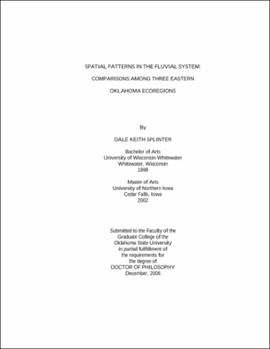| dc.contributor.advisor | Marston, Richard A. | |
| dc.contributor.author | Splinter, Dale Keith | |
| dc.date.accessioned | 2013-11-26T08:29:52Z | |
| dc.date.available | 2013-11-26T08:29:52Z | |
| dc.date.issued | 2006-12 | |
| dc.identifier.uri | https://hdl.handle.net/11244/7118 | |
| dc.description.abstract | Scope and Method of Study: Ecoregions are homogeneous regions delineated by similar associations of geology, climate, soils, land use, and potential natural vegetation. Ecoregions provide a spatial framework to establish whether geographic phenomena differ between ecoregions. A study was initiated to establish whether watershed morphology and the characteristics of stream channels could be differentiated by ecoregions in eastern Oklahoma: the Ozark Highlands, Boston Mountains, and Ouachita Mountains were selected for study. One hundred and forty-nine watersheds and stream reaches were randomly selected for investigation. | |
| dc.description.abstract | Findings and Conclusions: Four lines of inquiry were used to evaluate whether differences exist among ecoregions. These include morphometric analyses of watersheds, upstream-to-downstream trends in channel morphology, dissimilarity and cluster analysis of variables for watersheds and reaches, and classification of stream reaches. Statistical results are reported at 0.05. Morphometric analyses of drainage density, circularity ratio, relief, relief ratio, and ruggedness number reveal statistical differences between some watershed orders and ecoregions. Regression coefficients were used to test for significant differences in the upstream-to-downstream trends in channel morphology. Significant differences exist in particle-size, bankfull width, and width-depth ratio. Cluster analysis and dissimilarity were conducted using a sum of squares method. The most dissimilar watersheds and stream reaches exist in the Ouachita Mountains. A chi-squared test reported no differences between Rosgen stream classifications by region and stream order. Spatial patterns of the types of reaches, however, could be inferred in the upstream-to-downstream direction. The results of this study show that ecoregions in eastern Oklahoma provide a spatial framework that explains morphological differences in watersheds and reaches, clusters and dissimilarity, and the characteristics of channel reaches. | |
| dc.format | application/pdf | |
| dc.language | en_US | |
| dc.rights | Copyright is held by the author who has granted the Oklahoma State University Library the non-exclusive right to share this material in its institutional repository. Contact Digital Library Services at lib-dls@okstate.edu or 405-744-9161 for the permission policy on the use, reproduction or distribution of this material. | |
| dc.title | Spatial patterns in the fluvial system: Comparisons among three eastern Oklahoma ecoregions | |
| dc.contributor.committeeMember | Fisher, William L. | |
| dc.contributor.committeeMember | Vitek, John D. | |
| dc.contributor.committeeMember | Carter, Brian J. | |
| osu.filename | Splinter_okstate_0664D_2097 | |
| osu.accesstype | Open Access | |
| dc.type.genre | Dissertation | |
| dc.type.material | Text | |
| thesis.degree.discipline | Environmental Science | |
| thesis.degree.grantor | Oklahoma State University | |
